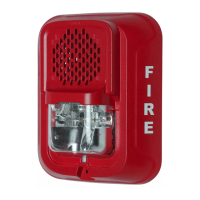LED L-series Indoor Horn Strobes and Strobes — P/N I56-0022-000 8/25/2023 3
Fire Alarm System Considerations Introduction
1.5 Fire Alarm System Considerations
The National Fire Alarm and Signaling Code, NFPA 72, and The National Building Code of Canada require that all notification appliances
used for building evacuation produce temporal coded signals. Signals other than those used for evacuation purposes do not have to produce
the temporal coded signal. System Sensor recommends spacing notification appliances in compliance with NFPA 72 (UL applications) or
CAN/ULC S524 (ULC applications).
1.6 System Design
The system designer must make sure that the total current draw by the devices on the loop does not exceed the current capability of the panel
supply, and that the last device on the circuit is operated within its rated voltage. The current draw information for making these calculations
can be found in the tables within the manual. For convenience and accuracy, use the voltage drop calculator on the System Sensor website
(www.systemsensor.com).
When calculating the voltage available to the last device, it is necessary to consider the voltage due to the resistance of the wire. The thicker
the wire, the smaller the voltage drop. Wire resistance tables can be obtained from electrical handbooks. Note that if Class A wiring is
installed, the wire length may be up to twice as long as it would be for circuits that are not fault tolerant. Total number of strobes on a single
NAC must not draw more current than supported by the Fire Alarm Control Panel (FACP).

